List of monarchs of Laos
| King of Laos | |
|---|---|
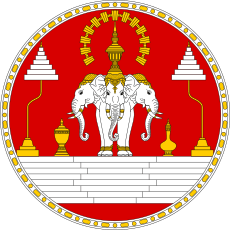 | |
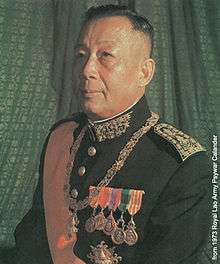 Savang Vatthana | |
| Details | |
| Style | His Royal Majesty |
| First monarch | Fa Ngum |
| Last monarch | Savang Vatthana |
| Formation | 1353 (Kingdom of Lan Xang) |
| Abolition | December 2, 1975 (Lao People's Democratic Republic) |
| Residence | Royal Palace, Luang Prabang, Laos |
| Appointer | Hereditary |
| Pretender(s) | Soulivong Savang |
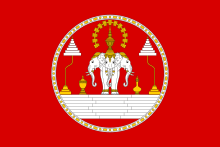
The Lao People's Democratic Republic is the modern state derived from the former kingdoms of Laos. The political source of Lao history and cultural identity is the Tai kingdom of Lan Xang, which during its apogee emerged as one of the largest kingdoms in Southeast Asia. Lao history is filled with frequent conflict and warfare, but infrequent scholarly attention. The resulting dates and references are approximate, and rely on source material from court chronicles which survived both war and neglect, or outside sources from competing neighboring kingdoms in what are now China, Vietnam, Burma, Thailand, and Cambodia.
Lao kingship was based upon the mandala system established by the example of King Ashoka. In theory, Lao kings and their successors were chosen by agreement of the king’s Sena (a council which could include senior royal family members, ministers, generals and senior members of the sangha or clergy), through the validity the king’s lineage, and by personal Dharma through commitment to propagating Theravada Buddhism (the king was literally a Dharmaraja- as one who led by acts of religious virtue). Kingship was not based exclusively on primogeniture or divine right as was common in other monarchies.
The monarchy traces its lineage to Chao Fa Ngum, who founded the Kingdom of Lan Xang in 1353 and beyond that to the mythical Khun Borom who was held as the mythical father of the Tai peoples and the progenitor of the Lao Loum.
Lan Xang endured as a politically unified entity for three hundred years (1353–1694), which was then split into the kingdoms of Vientiane, Luang Prabang, and Champasak, only to be reconstituted as a unified constitutional monarchy under a French protectorate in 1946. At various times the kingdom Lan Xang fought off invasions from Burma, Siam and the Đại Việt.
The traditional capital of Lan Xang was at Luang Prabang until it was moved in 1560 by King Setthathirath to better administer the growing population and provide security in facing threats from Burma and Siam. Lan Xang entered a Golden Age during the reigns of Visunarat (1501–1520) and Sourigna Vongsa from (1637–94), during these times the cultural and economic power of the kingdom were at their greatest. In 1828 Vientiane was razed by the Siamese, in retaliation for the Chao Anouvong Rebellion, at which point the kingdom of Vientiane ceased to exist. During the French Protectorate, Luang Prabang was reestablished as the cultural and religious capital, while the French rebuilt Vientiane as the country’s administrative capital.
Kingdom of Lan Xang (1353–1707)
The following is a list of Lan Xang kings from the founding in 1353 by Fa Ngum, to the succession disputes following the death of Souligna Vongsa, and partition of the Kingdom in 1707.
- Kings
| Name | Birth | Reign from |
Reign until |
Death | Relationship with predecessors |
Notes |
|---|---|---|---|---|---|---|
| Fa Ngum | 1316 | 1353 | 1373 | 1393 | [1] | |
| Samsenethai (Oun Huan) |
1357 | 1372 | 1417 | Son of Fa Ngum | [2] | |
| Lan Kham Deng | 1375 | 1416 | 1428 | Son of Samsenethai | [3] | |
| Phommathat | 1428 | 1429 | Lan Kham Deng's oldest son | Reigned 10 months[4] | ||
| Yukhon (Meunsai) |
1429 | 1430 | Younger brother of Phommathat | Reigned 8 months[5] | ||
| Khon Kham | 1430 | 1432 | Son of King Samsenthai | Reigned 18 months[6] | ||
| Kham Tam Sa (Kham Teun, Khamtum) |
1429(?); 1432 | Son of Samsenthai | Reigned 5 months[7] | |||
| Lusai | 1432 | 1433 | Son of Samsenthai | Reigned 6 months [8] | ||
| Khai Bua Ban | 1433 | 1436 | Grandson of Samsenthai | [9] | ||
| Kham Keut (Kham-Kert, Kham Keul) |
1436 | 1438 | Illegitimate son of Samsenethai | [10] | ||
| Nang Keo Phimpha | 1343 | 1438 | [11] | |||
| Interregnum (1438–1442, rule by Sena and members of Sangha)[12] | ||||||
| Chakkaphat Phaen Phaeo (Sai Tia Kaphut or Xainyachakkaphat) |
1415 | 1442 | 1480 | 1481 | Son of Samsenthai | [13] |
| Souvanna Banlang | 1455 | 1479 | 1486 | Son of Chakkaphat Phaen Phaeo | [14] | |
| La Sen Thai (La Sen Thai Puvanart) |
1462 | 1485 | 1496 | Youngest brother of Suvarna Banlang |
[15] | |
| Somphou | 1486 | 1496 | 1501 | Son of La Sen Thai | [16] | |
| Visoun (also Vixun or Visunarat) |
1465 | 1500 | 1520. | Son of Sai Tia Kaphut | [17] | |
| Photisarath I (also Phothisarath, Phothisarat, or Potisarat) |
1505 | 1520 | 1548 | Son of Visoun | [7] | |
| Setthathirath (also Xaysettha, Chaiyachettha, Chaiyaset or Jayajestha) |
1534 | 1548 | 1571 | Son of the Photisarath | Also King of Lanna r.1546-1551 [18] | |
| Sen Soulintha (also Saen Surintha or Sen Sourintha, born Chane Tian) |
1511 | 1571 | 1575 | 1582 | Not of royal descent | First reign. [19] |
| Voravongsa I | 1575 | 1579 | Son of Photisarath | Burmese vassal[20] | ||
| Sen Soulintha (also Saen Surintha or Sen Sourintha, born Chane Tian) |
1511 | 1580 | 1582 | Not of royal descent | Second reign [21] | |
| Nakhon Noi | 1582 | 1583 | Son of Sen Soulintha. Not of royal descent. |
[22] | ||
| Interregnum (1583–1591)[23] | ||||||
| Nokeo Koumane | 1591 | 1598 | Son of Setthathirath | [24] | ||
| Voravongsa II (Thammikarath) |
1598 | 1622 | Nephew of Setthathirath | [25] | ||
| Oupagnouvarath | 1622 | 1623 | Son of Voravongsa | [26] | ||
| Photisarath II | 1623 | 1627 | Son or grandson of Sen Soulintha Not of royal descent |
[27] | ||
| Mon Keo (Mongkeo) |
1627 | Son of Voravongsa | [28] | |||
| Tone Kham | 1627 | 1633 | Son of Mon Keo | [29][30] | ||
| Vichai | 1633 | 1637 | Son of Mon Keo | [31][30] | ||
| Souligna Vongsa (Sourinyavongsa) |
1618 | 1637 | 1695 | Son of Tone Kham | 2nd Golden Age of Lan Xang [32] | |
| Tian Thala | 1694 or 1695 | Not of royal descent. | Senior minister who usurped the throne reigning for 6 months.[33] | |||
| Ong Lo | 1694 | 1698 | Nephew of Souligna Vongsa | [34] | ||
| Nan Tharat | 1699 | Grandson of Vichai | [35] | |||
| Setthathirath II (Sai Ong Hue) |
1700 | 1707 | 1735 | Nephew of Souligna Vongsa (whose father was exiled to Vietnam) |
[36] | |
Kingdom of Vientiane (1707–1828)
.svg.png)
Kingdom of Vientiane was formed in 1707 as a result of the succession dispute between Sai Ong Hue with his backing from the Vietnamese court at Huế and Kingkitsarat (a grandson of Souligna Vongsa) who was backed by the Tai Lü kingdom of Sipsong Panna. From 1707 until the annihilation of Vientiane in 1828, the kingdom would at various times be in rivalry with the kingdoms of Luang Prabang and Champasak, although they remained loosely confederated by cultural and historic affinity. By the mid-eighteenth century, the individual Lao kingdoms were simultaneously paying tribute to Burma, China, Siam and Vietnam. Following the Rebellion of Chao Anouvong in 1828, Vientiane was destroyed and both the kingdoms of Vientiane and Champasak falls to the Siamese in 1828. The kingship of Vientiane ends and all territories are annexed to Siam.[37] General Ratchasuphawadi oversees the depopulation of the kingdom and forced relocation to Isaan. The city itself was leveled leaving only Wat Si Saket standing, along with the partial ruins of the Ha Pra Keo, That Dam Stupa, and That Luang Stupa. In 1867, Louis de Carne a part of the Francis Garnier exploratory mission noted that:
“A flourishing capital has been annihilated in our own days, and an entire people has, in some sort, disappeared, without Europe even having suspected such scenes of desolation-without even a solitary echo of this long cry of despair having reached her.”[38]
- Kings
| Name | Birth | Reign from |
Reign until |
Death | Relationship with predecessors |
Notes |
|---|---|---|---|---|---|---|
| Setthathirath II (Sai Ong Hue; Trieu Phuc) |
1685 | 1707 | 1735 | Nephew of Souligna Vongsa | ||
| Ong Long | 1735 | 1760 | Son of Sai Ong Hue | Burmese vassal, 1765–1768 | ||
| Ong Boun (Siribunyasarn) |
1760 | 1778 | Son of Sai Ong Hue | 1st reign. Burmese vassal)[39] | ||
| Interregnum (1778–1780). Phraya Supho appointed governor by Siamese, led by General Taksin. Vientiane falls and is sacked by the Siamese (1779) | ||||||
| Ong Boun (Siribunyasarn) |
1780 | 1781 | Son of Sai Ong Hue | 2nd reign, returns as vassal to Siam | ||
| Nanthasen | 1781 | 1794 | Son of Ong Boun | Returns Pra Bang to Vientiane, vassal to Siam, but recalled for plotting a rebellion | ||
| Intharavong (Intharavong Setthathirath III) |
1795 | 1805 | Son of Ong Boun | Vassal to Siam | ||
| Anouvong | 1767 | 1804 | 1828 | 1829 | Brother of Inthavong | Led the Lao rebellion (1826–1828) against Siam |
Kingdom of Champasak (Bassac) (1713–1904)
.svg.png)
The Kingdom of Champasak declared itself independent from the Kingdom of Vientiane in 1713. The Kingdom of Champasak comprised the area south of the Xe Bang River as far as Stung Treng together with the areas of the lower Mun and Xi rivers on the Khorat Plateau (now the Isaan area of modern Thailand). The Kingdom was annexed by Siam in 1829 following the Chao Anouvong Rebellion, and subsequent kings were confirmed in Bangkok. From 1893 French took administrative control over parts of the kingdom, in 1904 the kingdom was reduced to a provincial governorship but still included the political involvement of the Na Champasak royal family. From 1941–45 Thailand exploited France’s weakness during World War II to acquire Champasak and other Lao lands on the right bank of the Mekong. In 1946 Champasak was ceded back to France and Chao Boun Oum remitted all claims to an independent kingship in order to unify Laos. The Kingdom of Laos (1946–75) was then formed under the Luang Prabang line of kingship.
- Kings
| Name | Birth | Reign from |
Reign until |
Death | Relationship with predecessors |
Notes |
|---|---|---|---|---|---|---|
| Nokasad (Soysisamut Phutthangkun) |
1693(?) | 1713 | 1737 | 1738 | Grandson of Sourigna Vongsa | |
| Sayakumane
(Pha Photi Chao) |
1737 | 1791 | Son of Nokasat | |||
| Fay Na | 1791 | 1811 | Not of royal descent | Appointed by Siam | ||
| No Muong | 1811 | 1813 | Son of Sayakumane | |||
| Manoi | 1813 | 1819 | Nephew of Sayakumane | |||
| Nho | 1819 | 1827 | Son of Anouvong, King of Vientiane | Chao Yo house of Vientiane | ||
| 1829–93 Siam annexes Champasak following the Chao Anouvong Rebellion and confirms subsequent kings | ||||||
| Huy | 1780 | 1828 | 1840 | Great grandson of Nokasad | ||
| Nark | 1841 | 1851 | Brother of Huy | |||
| Boua | 1853 | Son of Huy | Regent: 1851–1853 | |||
| Interregnum (1853–1856) | ||||||
| Kham Nai | 1830 | 1856 | 1858 | Son of Huy | ||
| Interregnum (1858–63) | ||||||
| Kham Souk | 1839 | 1863 | 1899 | Son of Huy | France divided the kingdom in 1893 | |
| Ratsadanay (Nhouy) |
1874 | 1900 | 1904 | 1945 | Son of Kham Souk | King under protectorate of French Indochina; Had the title of regional governor between 1904–1934 |
| Boun Oum | 1911 | 1946 | 1980 | Son of Ratsadanay | Prince ceded all hereditary claims to reinforce the Kingdom of Laos | |
Kingdom of Luang Prabang (1707–1946)
.svg.png)
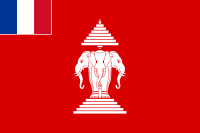
With the division of Lan Xang, the city of Luang Prabang recovered its prestige as a royal city, since the capital had moved to Vientiane with Setthathirath in 1560. The city was a growing center for religion and trade, but remained politically weak and would be sacked by the Burmese in 1764. Throughout the 18th and 19th centuries the Kingdom endured as a vassal to China, Siam, Burma, and Vietnam. In 1828 following Chao Anouvong’s Rebellion the kingdom was annexed by Siam. Despite their vassal status the Kings of Luang Prabang exercised a degree of autonomy, but lacked the security apparatus to effectively defend the kingdom (which may have been used in rebellion, as had been done in the kingdoms of Vientiane and Champasak). As a result, throughout the mid-19th century Haw pirates from China were able to invade.
- Kings
| Name | Birth | Reign from |
Reign until |
Death | Relationship with predecessors |
Notes |
|---|---|---|---|---|---|---|
| Kingkitsarat
(Kitsarat) |
1707 | 1713 | Grandson of Souligna Vongsa | |||
| Ong Kham | 1713 | 1723 | Cousin of Kingkitsarat and Inthasom | Co-ruled with Inthasom who then deposed him in 1723. Ong Kham was later crowned King of Lan Na (r.1727–1759) | ||
| Inthasom
(Thao Ang) |
1723 | 1749 | Brother of Kingkitsarat and grandson of Souligna Vongsa |
|||
| Vietnamese invasion repelled (1749) | ||||||
| Inthaphom | 1749 | Son of Inthasom | ||||
| Sotika Koumane | 1749 | 1764 | Son of Inthasom | Burmese vassal, 1765–1768 | ||
| Burmese invasion (1764, aided by Vientiane) | ||||||
| Sotika Koumane | 1764 | 1771 | Son of Inthasom | Vassal to Burma, abdicated in 1771 | ||
| Suriyawong | 1771 | 1779 | Brother of Sotika Koumane and son of Inthasom, |
Rebelled against Burma. In 1779, following the sack of Vientiane, Suriyawong becomes a vassal of Siam | ||
| Anourouth | 1791 | 1817 | Son of Inthasom | |||
| Mantha Tourath | 1817 | 1836 | Son of Anourouth | Sought vassalage with Vietnam against Siam | ||
| Provinces of Luang Phrabang in rebellion against Siam (1835) | ||||||
| Soukhaseum | 1838 | 1851 | Son of Mantha Tourath | |||
| Tiantharath | 1851 | 1870 | Son of Mantha Tourath | |||
| The Pra Bang is returned to Luang Pra Bang by King Chulalongkorn of Thailand having been brought to Bangkok during the destruction of Vientiane in 1828. Until 1865, Thai King Chantharath ruled Luang PraBang, and relinquished the power to Laos King Oun Kham. Transition occurred during/after the French Auguste Parvie visits. | ||||||
| Oun Kham | 1811 or 1816 |
1865 | 1895 | Son of Mantha Tourath | Fled to the Haw pirates in 1887 with Auguste Pavie and would later pursue protection from France | |
| Khamsouk (Sakharine, Sackarindr) |
1895 | 1904 | Son of Oun Kham | Was crowned after the French could establish security | ||
| Sisavang Vong | 1904 | 1945 | Son of Sakharine | Last king of Luang Prabang and first king of Laos | ||
Principality of Xiang Khouang (Muang Phuan) (1707–1899)
The Muang of Xiang Khouang was a semi-autonomous region in Laos in what is now Xiang Khouang province. The Phuan (Pu’on) monarchy claims descent from Khun Borom and were part of the Lan Xang mandala. Geographic isolation and frequent warfare produced periods where the Phuan kings tried to assert more authority, but the region remained only a key vassalage for surrounding kingdoms. The region features prominently in the 18th and 19th century as valuable coalition piece for the rival kingdoms of Vientiane and Champasak. Xiang Khouang was a trade frontier, and also frequent point of invasion, and so has more cultural influences from China and Vietnam.
- Kings
| Name | Birth | Reign from |
Reign until |
Death | Relationship with predecessors |
Notes |
|---|---|---|---|---|---|---|
| Kham Sanh | 1651 | 1688 | ||||
| Kam Lan | 1688 | 1700 | Son of Kham Sanh | |||
| Kham Sattha | 1723 | 1751 | Grandson of Kam Lan | Tributary to Vietnam, Luang Prabang, and Vientiane) | ||
| Ong Lo | 1751 | 1779 | ||||
| Somphou | 1779 | 1803 | ||||
| Noi (Southaka Souvanna Koumar) |
1803 | 1831 | Nephew of Somphou | Executed by Emperor Minh Mạng of Vietnam | ||
| Xiang Khuoang annexed as Tran Ninh province in Vietnam (1832) | ||||||
| Po | 1848 | 1865 | Son of Noi | Vassal to Siam and Vietnam | ||
| Ung | 1866 | 1876 | Son of Noi | Haw pirates invade Xiang Khouang in 1874 | ||
| Khanti | 1876 | 1880 | Son of Ung | Vassal to Siam | ||
| Kham Ngon | 1880 | 1899 | French protectorate ends autonomy | |||
Kingdom of Laos (1946–75)
.svg.png)
The Kingdom of Laos created in 1946 marked the first time the kingdoms of Laos had been unified since the division of Lan Xang in 1707. The Franco-Lao Treaty of 1953, gave Laos independence and the Royal Lao Government took control of the country. This treaty established a constitutional monarchy, with Sisavang Vong as King and Prince Souvanna Phouma as Prime Minister. In 1959, after the death of his father King Sisavang Vong, Savang Vatthana ascended the throne and was crowned King. On December 2, 1975, King Savang Vatthana was forced to abdicate by the Pathet Lao, after its victory in the Laotian Civil War.
| Name | Portrait | House | Birth | Death | Succession right |
|---|---|---|---|---|---|
| Sisavang Vong 23 April 1946 – 29 October 1959 13 years, 189 days | 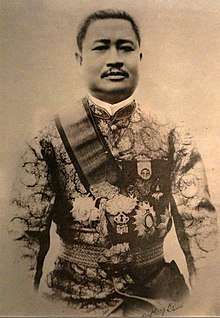 | Khun Lo | 14 July 1885 Luang Phrabang | 29 October 1959 Luang Phrabang aged 74 | Son of Zakarine |
| Savang Vatthana 29 October 1959 – 2 December 1975 16 years, 34 days |  | Khun Lo | 13 November 1907 Luang Phrabang | 13 May (?) 1978 or 1984 Xam Neua aged 70 or 77 | Son of Sisavang Vong |
Monarchy of Laos in exile (1975–present)
- Princes
- Vong Savang (Crown Prince, died c. 1978 in re-education camps with his father King Sisavang Vatthana)
- Sauryavong Savang (Regent, son of Sisavang Vatthana)
- Soulivong Savang (Pretender, son of Vong Savang)
- Thanyavong Savang
Lao monarchs' family tree
| Lao monarchs' family tree | |||||||||||||||||||||||||||||||||||||||||||||||||||||||||||||||||||||||||||||||||||||||||||||||||||||||||||||||||||||||||||||||||||||||||||||||||||||||||||||||||||||||||||||||||||||||||||||||||||||||||||||||||||||||||||||||||||||||||||||||||||||||||||||||||||||||||||||||||||||||||||||||||||||||||||||||||||||||||||||||||||||||||||||||||||||||||||||||||||||||||||||||||||||||||||||||||||||||||||||||||||||||||||||||||||||||||||||||||||||||||||||||||||||||||||||||||||||||||||||||||||||||||||||||||||||||||||||||||||||||||||||||||||||||||||||||||||||||||||||||||||||||||||||||||||||||||||||||||||||||||||||||||||||||||||||||||||||||||||||||||||||||||||||||||||||||||||||||||||||||||||||||||||||||||||||||||||||||||||||||||||||||||||||||||||||||||||||||||||||||||||||||||||||||||||||||||||||||||||||||||||||||||||||||||||||||||||||||||||||||||||||||||||||||||||||||||||||||||||||||||||||||||||||||||||||||||||||||||||||||||||||||||||||||||||||||||||||||||||||||||||||||||||||||||||||||||||||||||||||||
|---|---|---|---|---|---|---|---|---|---|---|---|---|---|---|---|---|---|---|---|---|---|---|---|---|---|---|---|---|---|---|---|---|---|---|---|---|---|---|---|---|---|---|---|---|---|---|---|---|---|---|---|---|---|---|---|---|---|---|---|---|---|---|---|---|---|---|---|---|---|---|---|---|---|---|---|---|---|---|---|---|---|---|---|---|---|---|---|---|---|---|---|---|---|---|---|---|---|---|---|---|---|---|---|---|---|---|---|---|---|---|---|---|---|---|---|---|---|---|---|---|---|---|---|---|---|---|---|---|---|---|---|---|---|---|---|---|---|---|---|---|---|---|---|---|---|---|---|---|---|---|---|---|---|---|---|---|---|---|---|---|---|---|---|---|---|---|---|---|---|---|---|---|---|---|---|---|---|---|---|---|---|---|---|---|---|---|---|---|---|---|---|---|---|---|---|---|---|---|---|---|---|---|---|---|---|---|---|---|---|---|---|---|---|---|---|---|---|---|---|---|---|---|---|---|---|---|---|---|---|---|---|---|---|---|---|---|---|---|---|---|---|---|---|---|---|---|---|---|---|---|---|---|---|---|---|---|---|---|---|---|---|---|---|---|---|---|---|---|---|---|---|---|---|---|---|---|---|---|---|---|---|---|---|---|---|---|---|---|---|---|---|---|---|---|---|---|---|---|---|---|---|---|---|---|---|---|---|---|---|---|---|---|---|---|---|---|---|---|---|---|---|---|---|---|---|---|---|---|---|---|---|---|---|---|---|---|---|---|---|---|---|---|---|---|---|---|---|---|---|---|---|---|---|---|---|---|---|---|---|---|---|---|---|---|---|---|---|---|---|---|---|---|---|---|---|---|---|---|---|---|---|---|---|---|---|---|---|---|---|---|---|---|---|---|---|---|---|---|---|---|---|---|---|---|---|---|---|---|---|---|---|---|---|---|---|---|---|---|---|---|---|---|---|---|---|---|---|---|---|---|---|---|---|---|---|---|---|---|---|---|---|---|---|---|---|---|---|---|---|---|---|---|---|---|---|---|---|---|---|---|---|---|---|---|---|---|---|---|---|---|---|---|---|---|---|---|---|---|---|---|---|---|---|---|---|---|---|---|---|---|---|---|---|---|---|---|---|---|---|---|---|---|---|---|---|---|---|---|---|---|---|---|---|---|---|---|---|---|---|---|---|---|---|---|---|---|---|---|---|---|---|---|---|---|---|---|---|---|---|---|---|---|---|---|---|---|---|---|---|---|---|---|---|---|---|---|---|---|---|---|---|---|---|---|---|---|---|---|---|---|---|---|---|---|---|---|---|---|---|---|---|---|---|---|---|---|---|---|---|---|---|---|---|---|---|---|---|---|---|---|---|---|---|---|---|---|---|---|---|---|---|---|---|---|---|---|---|---|---|---|---|---|---|---|---|---|---|---|---|---|---|---|---|---|---|---|---|---|---|---|---|---|---|---|---|---|---|---|---|---|---|---|---|---|---|---|---|---|---|---|---|---|---|---|---|---|---|---|---|---|---|---|---|---|---|---|---|---|---|---|---|---|---|---|---|---|---|---|---|---|---|---|---|---|---|---|---|---|---|---|---|---|---|---|---|---|---|---|---|---|---|---|---|---|---|---|---|---|---|---|---|---|---|---|---|---|---|---|---|---|---|---|---|---|---|---|---|---|---|---|---|---|---|---|---|---|---|---|---|---|---|---|---|---|---|---|---|---|---|---|---|---|---|---|---|---|---|---|---|---|---|---|---|---|---|---|---|---|---|---|---|---|---|---|---|---|---|---|---|---|---|---|---|---|---|---|---|---|---|---|---|---|---|---|---|---|---|---|---|---|---|---|---|---|---|---|---|---|---|---|---|---|---|---|---|---|---|---|---|---|---|---|---|---|---|---|---|---|---|---|---|---|---|---|---|---|---|---|---|---|---|---|---|---|---|---|---|---|---|---|---|---|---|---|---|---|---|---|---|---|---|---|---|---|---|---|---|---|---|---|---|---|---|---|---|---|---|---|---|---|---|---|---|---|---|---|---|---|---|---|---|---|---|---|---|---|---|---|---|---|---|---|---|---|---|---|---|---|---|---|---|---|---|---|---|---|---|---|---|---|---|---|---|---|---|---|---|---|---|---|---|---|---|---|---|---|---|---|---|---|---|---|---|---|---|---|---|---|---|---|---|---|---|---|---|---|---|---|---|---|---|---|---|---|---|---|---|---|---|---|---|---|---|---|---|---|---|---|---|---|---|---|---|---|---|---|---|---|---|
| |||||||||||||||||||||||||||||||||||||||||||||||||||||||||||||||||||||||||||||||||||||||||||||||||||||||||||||||||||||||||||||||||||||||||||||||||||||||||||||||||||||||||||||||||||||||||||||||||||||||||||||||||||||||||||||||||||||||||||||||||||||||||||||||||||||||||||||||||||||||||||||||||||||||||||||||||||||||||||||||||||||||||||||||||||||||||||||||||||||||||||||||||||||||||||||||||||||||||||||||||||||||||||||||||||||||||||||||||||||||||||||||||||||||||||||||||||||||||||||||||||||||||||||||||||||||||||||||||||||||||||||||||||||||||||||||||||||||||||||||||||||||||||||||||||||||||||||||||||||||||||||||||||||||||||||||||||||||||||||||||||||||||||||||||||||||||||||||||||||||||||||||||||||||||||||||||||||||||||||||||||||||||||||||||||||||||||||||||||||||||||||||||||||||||||||||||||||||||||||||||||||||||||||||||||||||||||||||||||||||||||||||||||||||||||||||||||||||||||||||||||||||||||||||||||||||||||||||||||||||||||||||||||||||||||||||||||||||||||||||||||||||||||||||||||||||||||||||||||||||
See also
References
- ↑ [(Simms, Peter and Sanda, The Kingdoms of Laos: Six Hundred Years of History, Curzon Press, Surrey. 1999. ISBN 0-7007-1531-2. (pg. 217); Le Boulanger, Paul, Histoire du Laos Francais: Essai d'une Etude chronologique des Principautes Laotiennes, Plon, Paris. 1931 (pg.31); Dommen, Aurthur, J., Conflict in Laos: The Politics of Neutralization, Pall Mall Press, London. 1964. (pg. 64); Hall, D.G.E., A History of Southeast Asia (4th ed.), Macmillan, London, 1994. ISBN 978-0333241646 (pg. 81)]
- ↑ (Simms, 99; Le Boulanger, 31; Sila, 64; Manich, 67; Hall, 81; Stuart-Fox, 93)
- ↑ (Simms, 99; Le Boulanger, 31; Hall, 81)
- ↑
- ↑ (Simms, 99; Sila, Maha Viravong, History of Laos (trans), Paragon, New York. 1964.
- ↑ (Simms, 99; Sila, 64)
- 1 2 (Simms, 99; Le Boulanger, 31)
- ↑ (Simms, 99; Sila, 64; Manich, 71; Le Boulanger, 31)
- ↑ (Simms, 99; Sila, 64; Manich, 71)
- ↑
- ↑ (Stuart-Fox, Martin “Who was Maha Thevi?" Siam Society Journal, Vol 81. 1993.; ---, The Lao Kingdom of Lan Xang: Rise and Decline, White Lotus Press, 1998. ISBN 974-8434-33-8. (pgs. 62-64).
- ↑ (Simms, 99; Manich, 71)
- ↑ (Simms, 99; Le Boulanger, 31; Dommen, 64)
- ↑
- ↑ (Simms, 99; Le Boulanger, 31; Hall, 81; Wyatt, David K. & Aroonrut Wichienkeeo (Ed.), The Chiang Mai Chronicle (trans), Silkworm, Chiang Mai, 1995. ISBN 9747100622
- ↑ (Simms, 99; Le Boulanger, 31; Hall, 81; Wyatt, 84)
- ↑ (Simms, 99; Sila, 64; Coedes, George, The Making of Southeast Asia (trans) Routledge & Kegan Paul, London, 1966.; Stuart-Fox, 93)
- ↑ (Simms, 218; Manich, 67; Saveng, 87; Wyatt, 84)
- ↑ (Sila, 64; Saveng, Phinith, Contribution a l'Histoire du Royaume de Luang Prabang., École Française d'Extrême-Orient, Vol. CXLI, Paris, 1987.)
- ↑ (Sila, 64; Manich, 67; Saveng, 87)
- ↑ (Simms, 99; Hall, 81; Saveng, 87)
- ↑ (Simms, 99; Le Boulanger, 31; Sila, 64; Hall, 81)
- ↑
- ↑ (Simms, 99; Le Boulanger, 31; Coedes, 66; Hall, 81; Saveng, 87
- ↑ (Sila, 64; Saveng, 87)
- ↑ (Simms, 99; Le Boulanger, 31; Sila, 64)
- ↑ (Simms 99, Le Boulanger, 31; Sila, 64)
- ↑ (Sila, 64)
- ↑
- 1 2 Simms, Sanda (2013-10-11). The Kingdoms of Laos. Routledge. ISBN 9781136863370.
- ↑
- ↑ (Coedes, 66; Le Boulanger, 31; Dommen, 64; Saveng, 87; Stuart-Fox, 93)
- ↑ (Simms, 99, Le Boulanger, 31; Hall, 81)
- ↑ (Manich, 67)
- ↑ (Saveng, 87)
- ↑ (Wyatt, 84; Le Boulanger, 31; Dommen, 64; Hall, 81)
- ↑ (Stuart-Fox, 98; Simms, 99; Sila, 84, Le Thanh Khoi, Histoire du Vietnam, Le Boulanger, Wyatt)
- ↑ (Stuart-Fox, Martin. Naga Cities of The Mekong.)
- ↑ Tarling, Nicholas. The Cambridge history of South East Asia: From c. 1500 to c. 1800. 1. Cambridge University Press. p. 238. ISBN 978-0-521-66370-0. ISBN 0-521-66370-9.